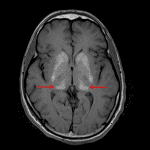Age: 22
Sex: Male
Indication: Seizure
Save ("V")
Case #3
Findings
- Symmetric T1 signal hyperintensity involving the bilateral basal ganglia, thalami (especially the pulvinar), and dentate nuclei with corresponding susceptibility artifact
- Patchy T2/FLAIR hyperintensities in the bilateral frontal periventricular white matter
- Additional linear areas of susceptibility artifact involving the bilateral cerebral subcortical and deep white matter, most pronounced in the frontal lobes
Diagnosis
Fabry disease
 Sample Report
Sample Report
No acute intracranial abnormality.
Symmetric T1 signal hyperintensity involving the bilateral basal ganglia, thalami (especially the pulvinar), and dentate nuclei with corresponding susceptibility artifact, likely relating to mineralization. Additional linear areas of susceptibility artifact involving the bilateral cerebral subcortical and deep white matter, most pronounced in the frontal lobes also likely represent mineralization. Given distribution and patient age, these findings are favored to represent Fabry disease. Disorders of calcium homeostasis including hyper- and hypoparathyroidism are additional diagnostic considerations.
Patchy T2/FLAIR hyperintensities in the bilateral frontal periventricular white matter, which are nonspecific but may relate to chronic small vessel ischemia.




 View shortcuts
View shortcuts Zoom/Pan
Zoom/Pan Full screen
Full screen Window/Level
Window/Level Expand/collapse
Expand/collapse Scroll
Scroll Save the case
Save the case Close case/tab
Close case/tab





 Previous series (if multiple)
Previous series (if multiple) Next series (if multiple)
Next series (if multiple)
